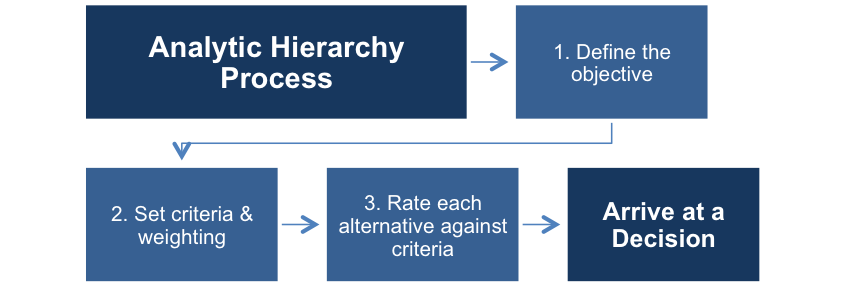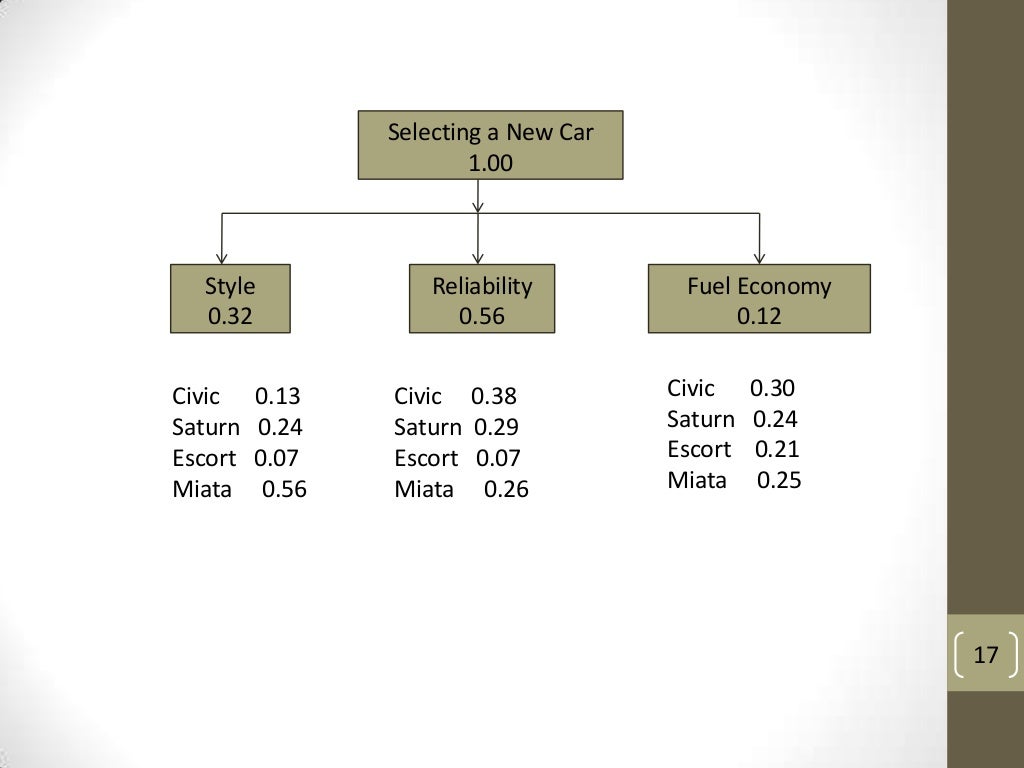

When a decision has to be taken, it assesses a set of alternatives through pair wise comparisons by deriving priority scales.

The AHP is one of the most commonly exploited multi criteria decision making approach. The AHP belongs to those methods which are with a cardinal level of information on criteria preferences based on a pair wise comparison. The principles of analytical thinking have led to the development of a useful model for the quantitative solution of problems involving multiple criteria decision making. This technique of Saaty is called ‘analytic hierarchy process’ (AHP) and it is based on a hierarchical structure. Saaty developed this technique for solving the complex problems. Thomas Saaty developed in 1970s a strong and helpful technique for managing qualitative and quantitative multi criteria elements involving in decision making behaviour. The decision is normally based on the perception of the individual who is supposed to make the final decision and to assess priorities, emphasizing the importance of consistency and correlation of the alternatives which has been compared in the complete decision making process. It aims to quantify the relative priority of the given set according to the appropriate value scale. The method of AHP is one of the most used methods in decision making processes. One way of making a correct decision is by application of multi-criteria optimization method. People face up with the decision making problems every day, starting from elementary problems to very complex situations. Even more frequently the pertinent data are very expensive to collect.Īpplications of the multiple criteria decision making methods are especially popular in the last few decades. Very frequently these criteria are conflicting with each other. It is not an exaggeration to argue that almost any industrial or organizational activity involves, in one way or the other, the evaluation of a set of alternatives in terms of a set of decision criteria. Multi criteria decision making plays a critical role in many real life problems. yield criteria) and minimize others (e.g. The basic characteristics of multiple criteria decision making are considered to be (i) multiple criteria nature of the decision making problem which means that the decision maker assesses selected alternatives on the basis of several criteria, (ii) non additivity of the criteria which means that the selected criteria are expressed in different units of measure, and (iii) mixed set of criteria which means that some criteria are quantitative and some are qualitative and the decision maker is to maximize some criteria (e.g. One of the biggest issues which the decision making theory deals with is the issue of multiple criteria decision making. It is the basis for the decision making theory, which aims to create appropriate procedures (methods) for solving decision making situations with the highest degree of universality. The formal-logical side of decision making is a precondition for claiming that there is a framework procedure for resolving a decision making situation with different content. There are two sides to the decision-making process, namely (i) the content side of decision making which reflects the differences of individual decision making processes, and (ii) the formal-logical (procedural) side of decision making which expresses that individual decision making processes have certain common features, regardless of their content. The decision making process can be defined as a set of activities which leads to the resolution of a decision making problem that involves at least two meaningful alternatives, of which the selected one offers the best result with respect to the set goal, as well as the possibility of its implementation. Knowing more does not guarantee that people understand better.ĭecision making is one of the most important activities performed by the organizational management which is also referred to as the core of management. There are a number of examples, which show that too much information is as bad as too little information. If people only make decisions intuitively, then they are inclined to believe that all kinds of information are useful and the larger the quantity, the better. Not all the information is useful for improving the understanding and judgements. The information they gather is for helping them to understand the occurrences, in order to develop good judgements to make decisions about those occurrences. Everything they do consciously or unconsciously is the result of some decision. AHP, Analytic hierarchy process, Consistency ratio, Decision making, Multi criteria decision making, Pair wise comparison, Relative measurement theory ,Īll the people are decision makers fundamentally.


 0 kommentar(er)
0 kommentar(er)
